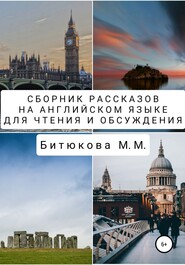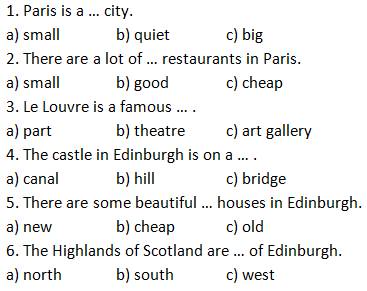
Полная версия:
Сборник рассказов на английском языке для чтения и обсуждения

Part 1
Story One
Daily routine
Max Portman lives in Oxford. He is married and has two small children. He teaches in a secondary school. He gets up early and has breakfast at 7 o'clock. He starts work at 8 o'clock and leaves work at 4 o'clock.
He likes his job because he likes teaching children. But he doesn't teach every day. On Tuesday and
Thursday he stays at home with his children.
Johanna Portman is Max's sister. She doesn't have children. She's only 23. And she doesn't live in Britain. She lives in Spain. She works in a travel agency in Madrid. She doesn't get up early. She starts work at 10 o'clock. She doesn't have breakfast. She has a sandwich for lunch at 12 o'clock. She likes her job because it is very interesting. At weekends she visits her boyfriend, Pablo. He lives in Barcelona.
Practice:
A. Complete these sentences about Max and Johanna:
1. Max ......... in Oxford.
2. He ............ in a secondary school.
3. He ........... two small children.
4. He ............. up early.
5. He ............ breakfast at 7 o'clock.
6. He ............ work at 4 o'clock.
7. Johanna ........... ............ in Britain.
8. She ................. ........... children.
9. She ................ ............ up early.
10. She ................ ........... breakfast.
11. She ................ ............ work at 4 o'clock.
B. Make Questions about Max and Johanna (both Yes-No and WH – question)
E.g. Does Max live in London? Where does he work?
C. Talk about your Daily Routine.
Story Two
Bob's busy day
Bob's day begins at 6:30. He gets up, takes a shower and gets dressed. He always has breakfast and drinks a cup of coffee. Then he goes to the university for his classes. When he finishes his morning classes, he usually eats lunch at 12:00 in the cafeteria. At lunch, he sometimes talks with his friends. After lunch he goes to his afternoon classes. He usually comes home at about 5:00. He eats dinner and relaxes for a while. Sometimes he takes a walk or goes running. For the rest of the evening he reads and does his homework. Bob goes to bed about 11:00 pm. What a busy day!
Practice:
A. Choose the correct answer:
1. What time does Bob get up?
a) 7:00 a.m
b) 6:30 a.m.
c) 12:00 noon
d) 11:00 p.m.
2. What does Bob do after he eats breakfast?
a) He gets dressed.
b) He takes a shower.
c) He reads.
d) He goes to class.
3. At lunch, Bob sometimes....
a) talks to his friends.
b) has a cup of tea.
c) studies for his afternoon classes.
d) listens to music.
4. What time does Bob go home?
a) 11:00 p.m.
b) 7:00 a.m.
c) 5:00 p.m.
d) 5:00 a.m.
5. After dinner Bob ....
a) does homework.
b) relaxes.
c) lifts weights.
d) goes home.
6. What time does Bob go to bed?
a) 11:00 p.m.
b) 11:00 a.m.
c) 12:00 midnight.
d) 11:30 p.m.
Story Three
Helena’s usual day
Hello. My name is Helena Lopez. I work in a large company in Monterrey, Mexico. We make bottles and cans for soft drinks. I am a secretary. I answer the telephone and take messages. I also use a fax machine and a computer. My first language is Spanish but sometimes I speak English. Many of our clients are from the United States. My supervisor is Mr. Gonzalez. He is an engineer. I start work at 8:00 am. I usually drive to work. I have lunch from 1:00 pm to 2:00 pm. I finish work at 5:30 pm. I go home and help my mother prepare dinner. We have dinner at 9:00 pm. After dinner I usually watch television for a while. I usually go to bed at 11:00 pm.
Practice:
A. Choose the correct answer:
1. Where does Helena live?
a) She starts work at 8:00.
b) She lives in Monterrey, Mexico.
c) She lives in a company.
d) She is a secretary.
2. Where does Helena work?
a) She is a secretary.
b) She starts work at 8:00.
c) She works in a company that makes bottles and cans.
d) She answers the telephone.
3. What does Helena do?
a) She answers the telephone.
b) She is an engineer.
c) She starts work at 8:00.
d) She is a secretary.
4. What languages does Helena speak?
a) Spanish.
b) English.
c) Mexican.
d) Spanish and English.
5. What time does Helena have lunch?
a) At 8:00.
b) From 1:00 to 2:00.
c) At 5:30.
d) At 9:00.
6. Helena can cook.
a) True
b) False
7. Helena and her family have dinner before 9:00.
a) True
b) False
8. Helena does not use a computer.
a) True
b) False
9. Mr. Torres is Helena's supervisor.
a) True
b) False
10. Helena likes to watch television in the evening.
a) True
b) False
Story Four
Estonia
Estonia is a small country in northern Europe between Russia and Finland. Tallinn is the capital city. It is a modern city, but in the old centre there are beautiful buildings from the 1200s. In this part of the city, a lot of the streets are very small, so there aren’t any cars on them. There are good restaurants and cafés, and they aren’t expensive. There are beautiful parks, interesting museums and three beaches, too.
The weather is good in summer, but not very hot. In July it is about 20°C. In winter, it is cold and often below zero.
There is an airport 4 kilometres from the city centre, and there are good buses from the airport to the city.
Practice:
Are these sentences about Tallinn True or False? Correct the false ones. Try not to look at the text.
1. Tallinn is the capital of Estonia. – True
2. The centre of the city is new.
3. There are a lot of cars in the old part of the city.
4. The cafés and restaurants in Tallinn are expensive.
5. There are seven beaches.
6. The winters are cold, but the summers are not.
7. There is an airport in the city centre.
Story Five
Paris
Paris is the capital of France. It’s a big city. The population is over two million. There are a lot of good French restaurants. The coffee is very good there! The River Seine is in Paris. There is a famous tower called the Eiffel Tower. A big street called ‘Champs-Élysées’ is near the Eiffel Tower.
There are some beautiful clothes shops in the city. Some are expensive and some are cheap. There are a lot of art galleries and a famous one called Le Louvre. Paris is a beautiful city.
Edinburgh
Edinburgh is a city in Scotland in the UK. It is often cold and wet in winter. Edinburgh is a very old city with a population of approximately half a million. There is a big castle on a hill in the city. There is a big street called ‘The Royal Mile’. There are some beautiful old houses in Edinburgh.
The city is famous for the Edinburgh festival every year in August. There are lots of theatre performances at the festival.
The Highlands of Scotland are north of Edinburgh.
Practice
A. Choose the correct answer.

B. Complete the table with the information about Paris and Edinburgh.

Story Six
Great lakes of the world
The oldest lake in the world
Lake Baikal is 25-30 million years old – the oldest lake in the world. It holds 20 percent of the planet’s surface freshwater. It is 650km long and nearly 2km deep.
Lake Baikal is in eastern Siberia where the winters are very cold. Temperatures average minus 20 degrees. The lake freezes for five months or more of the year. The ice is 1.2m thick, and trucks drive across the lake when it freezes.
The lake has more than 1 200 species of animals and 1 000 species of plants. It is home to the world’s only freshwater seal, the nerpa. There are approximately 50 000 nerpa in the lake. Nerpas can dive down 300m to catch fish!
Giant lakes
The world’s largest lake is the Caspian Sea in south-west Asia. It is 370 000 sq km. It is salt water and not freshwater. The world’s largest freshwater lake is Lake Superior, one of the Great Lakes of North America. These lakes are the biggest mass of freshwater in the world.
Stories about lakes
Scotland’s Loch Ness is famous for its ‘monster’, and is only 230m deep. But Lake Nicaragua in Central America is home to the dangerous bull shark, which is more than 3m long. The sharks swim up and down the San Juan River into the Caribbean Sea.
Practice
A. Read the text and complete the information in the table.

B. Answer the questions.
1. How old is Lake Baikal?
2. How long is Lake Baikal?
3. What happens to Lake Baikal in the winter?
4. What is the name of the seal that lives in Lake Baikal?
Конец ознакомительного фрагмента.
Текст предоставлен ООО «ЛитРес».
Прочитайте эту книгу целиком, купив полную легальную версию на ЛитРес.
Безопасно оплатить книгу можно банковской картой Visa, MasterCard, Maestro, со счета мобильного телефона, с платежного терминала, в салоне МТС или Связной, через PayPal, WebMoney, Яндекс.Деньги, QIWI Кошелек, бонусными картами или другим удобным Вам способом.
Вы ознакомились с фрагментом книги.
Для бесплатного чтения открыта только часть текста.
Приобретайте полный текст книги у нашего партнера:
Полная версия книги
Всего 10 форматов



